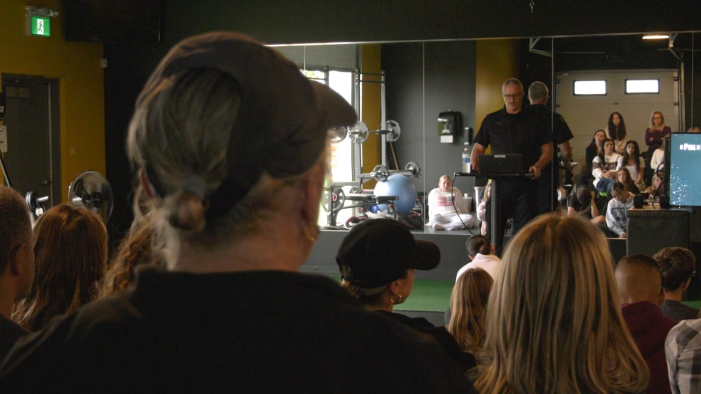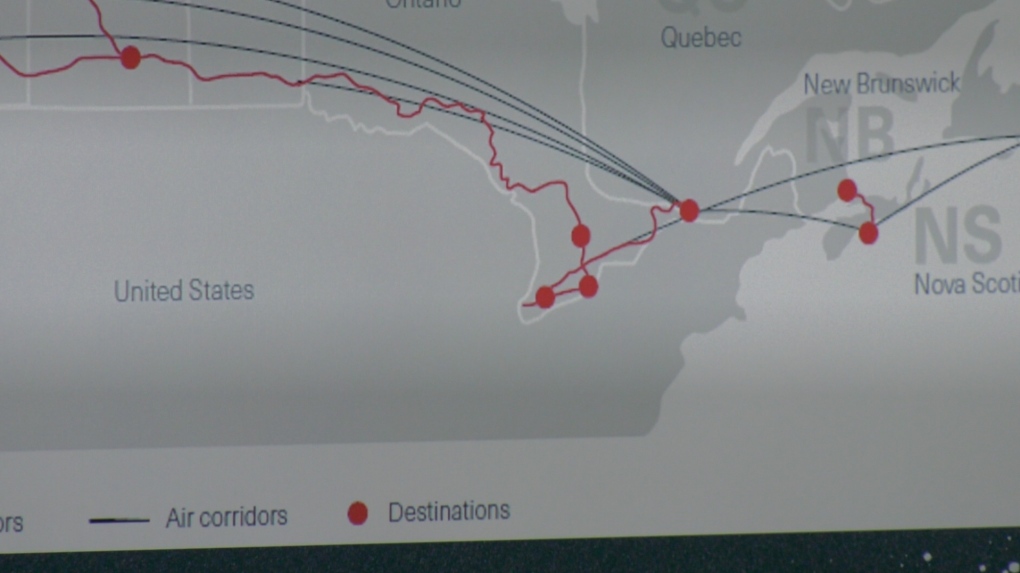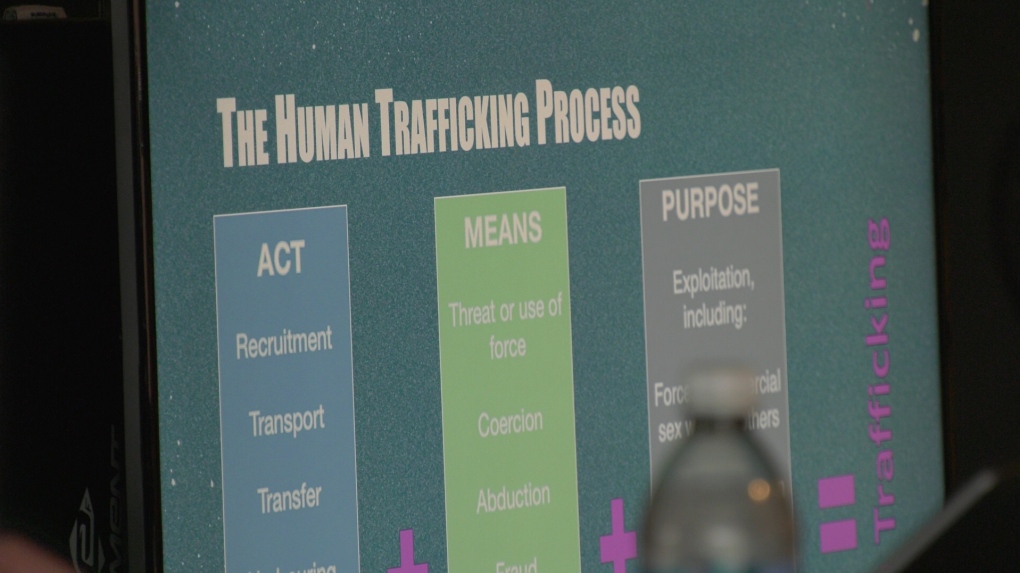How often do human smuggling cases happen in Canada's southern-most region? RCMP officer says daily
New cases of human smuggling along the shores of Canada's southernmost region occur almost daily, according to the Royal Canadian Mounted Police.
Const. Ian Smith of the RCMP Border Integrity Unit in Windsor made the comment this past weekend when he gave a presentation to teenagers and parents on the dangers of human trafficking and smuggling in neighbouring Tecumseh, Ont.
According to Smith, most smuggling cases involve "consenting people wanting to get into a country" in search of a better life.
These individuals often come from war-torn regions or countries with poor living conditions, hoping for better opportunities in Canada or the United States.
However, the journey is extremely risky. One of the most common methods used by smugglers is by boat.
 Const. Ian Smith speaks about the dangers of human trafficking and smuggling in Tecumseh, Ont. (Sanjay Maru/CTV News Windsor)
Const. Ian Smith speaks about the dangers of human trafficking and smuggling in Tecumseh, Ont. (Sanjay Maru/CTV News Windsor)
"You have to go across the water to get either into Canada or into the United States. So, if you're not prepared to cross the Detroit River, Lake St. Clair or Lake Erie, it could be very dangerous," said Smith, adding people often drown in those waters.
"Plus, you're providing money. Maybe you give the money, and you don't get the service you want."
While the Canada Border Services Agency (CBSA) investigates human smuggling at land borders, such as the Ambassador Bridge or Windsor-Detroit Tunnel, the RCMP is responsible for investigating smuggling over water.
Smith's presentation, however, primarily focused on a different topic: human trafficking — which is distinct from smuggling.
Human smuggling involves the consensual transport of people, whereas human trafficking is about exploiting people against their will through force or deception.
 A still of the slideshow shown to the audience on the dangers of human trafficking and smuggling. (Sanjay Maru/CTV News Windsor)
A still of the slideshow shown to the audience on the dangers of human trafficking and smuggling. (Sanjay Maru/CTV News Windsor)
"Traffickers will lure people into this lifestyle with the promise of a better life, with love, belonging, safety, a big house, family, lots of parties that include alcohol, drugs, money, etc.," said Smith.
Traffickers may groom victims by offering gifts or money, often starting by luring them through social media, including platforms that teens might not consider dangerous.
"Video gaming is a huge part of this too because we have a big gamer in the house. I’ve [seen] a few things and it’s a little scary," said one concerned parent during Smith's presentation.
According to the RCMP, traffickers have been known to use gaming platforms to make romantic advances toward young teens.
Over time, victims may fall in love or be coerced into using illicit drugs, making them easier to control.
The RCMP stresses that crossing borders isn’t necessary for human trafficking. The exploitative and psychologically manipulative nature of the crime defines it. That means a person can be considered a victim of human trafficking, even if they never leave their town or city.
 A slide shown to parents and teens on the dangers of human trafficking and smuggling. (Sanjay Maru/CTV News Windsor)
A slide shown to parents and teens on the dangers of human trafficking and smuggling. (Sanjay Maru/CTV News Windsor)
Federal officers urge anyone who suspects someone is being trafficked to report it to an adult, contact police or call the Canadian Human Trafficking Hotline at 1-833-900-1010.
When asked about the frequency of human trafficking cases across the province, Cpl. Nathan Murano of the RCMP's Border Integrity Program in Kingston said it's difficult to measure.
"Human trafficking often appears (or is reported) as adjacent offences such as: Sexual Exploitation, Human Smuggling, Assault, Sexual Assault, Forcible Confinement, etc.," said Murano in a statement.
Canadian statistics show a consistent increase in incidents related to human trafficking (as defined by Canada's Criminal Code) reported to police between 2012 and 2022, according to Murano.
In Ontario, he said 67 per cent of all reported human trafficking incidents in Canada occur within the province.
About 80 per cent of human trafficking incidents are reported "in urban centres," Murano said, adding statistics don't always reflect "the truest picture."
"One of the largest hurdles when dealing with human trafficking is the lack of reporting. The lack of reporting is often a result of the very real and complex trauma faced by victims and survivors alike," he said.
When asked which age groups are most targeted, the RCMP noted that 45 per cent of female victims in police-reported trafficking incidents are between 18 and 24.
For male victims, the most common age is between 25 and 34, representing roughly 35 per cent of reported incidents.
CTVNews.ca Top Stories

opinion Tom Mulcair: Prime Minister Justin Trudeau's train wreck of a final act
In his latest column for CTVNews.ca, former NDP leader and political analyst Tom Mulcair puts a spotlight on the 'spectacular failure' of Prime Minister Justin Trudeau's final act on the political stage.
B.C. mayor gets calls from across Canada about 'crazy' plan to recruit doctors
A British Columbia community's "out-of-the-box" plan to ease its family doctor shortage by hiring physicians as city employees is sparking interest from across Canada, says Colwood Mayor Doug Kobayashi.
'There’s no support': Domestic abuse survivor shares difficulties leaving her relationship
An Edmonton woman who tried to flee an abusive relationship ended up back where she started in part due to a lack of shelter space.
opinion King Charles' Christmas: Who's in and who's out this year?
Christmas 2024 is set to be a Christmas like no other for the Royal Family, says royal commentator Afua Hagan. King Charles III has initiated the most important and significant transformation of royal Christmas celebrations in decades.
Baseball Hall of Famer Rickey Henderson dead at 65, reports say
Rickey Henderson, a Baseball Hall of Famer and Major League Baseball’s all-time stolen bases leader, is dead at 65, according to multiple reports.
Arizona third-grader saves choking friend
An Arizona third-grader is being recognized by his local fire department after saving a friend from choking.
Germans mourn the 5 killed and 200 injured in the apparent attack on a Christmas market
Germans on Saturday mourned the victims of an apparent attack in which authorities say a doctor drove into a busy outdoor Christmas market, killing five people, injuring 200 others and shaking the public’s sense of security at what would otherwise be a time of joy.
Blake Lively accuses 'It Ends With Us' director Justin Baldoni of harassment and smear campaign
Blake Lively has accused her 'It Ends With Us' director and co-star Justin Baldoni of sexual harassment on the set of the movie and a subsequent effort to “destroy' her reputation in a legal complaint.
Oysters distributed in B.C., Alberta, Ontario recalled for norovirus contamination
The Canadian Food Inspection Agency has issued a recall due to possible norovirus contamination of certain oysters distributed in British Columbia, Alberta and Ontario.


































